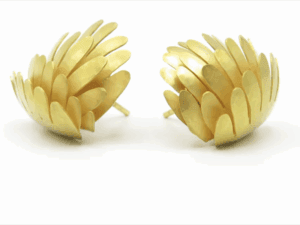This essay was first published in Signs of Change: Jewellery Designed to Make a Better World (Perth: Form, 2010). The accompanying exhibition was held at FORM Gallery in Perth, Australia, from April 9–May 30, 2010.
On the Tiger’s Back
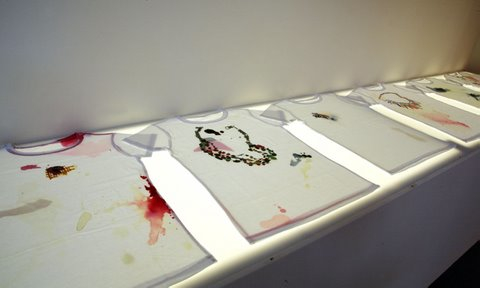
We can see the contemporary jewelry movement playing its own role in this progression. There are key moments, such as Ralph Turner’s 1976 exhibition Jewellery Redefined, which celebrated the introduction of non-precious materials, including paper and plastic. Jewelry was no longer limited to traditional components of splendor like gold and diamonds. The key is instead an artistic imagination that could transform ordinary materials into works of art. The new studio model positioned the jeweler as an artist. This meant the freedom to create work for its own sake, regardless of tradition, function or marketplace.
In Australia, this studio model arrived fortuitously at a time when Australian universities were undergoing a radical transformation. No longer bastions of privilege, they were expected to open their doors to near universal access. Previously taught as a trade, jewelry courses emerged now in universities where craft was seen as a theoretical field on par with visual arts, if not literature. Many students were the first in their family to have a tertiary education. It is natural that, as an upwardly mobile class took over bastions of privilege, it celebrated the overturning of traditions. The resulting work questioned our assumptions of jewelry, including what is precious in our world.
But, as the Chinese say, when you are on a tiger’s back, it is impossible to get off. The modernist critique that was once used to clear away tradition eventually starts undermining the structures that replaced it. The model of jeweler as artist, once a form of defiance against the traditional status as artisan, eventually becomes another myth to be debunked. The liberating quest of modernity seeks new frontiers. Where will they be found?
Ethical Turn
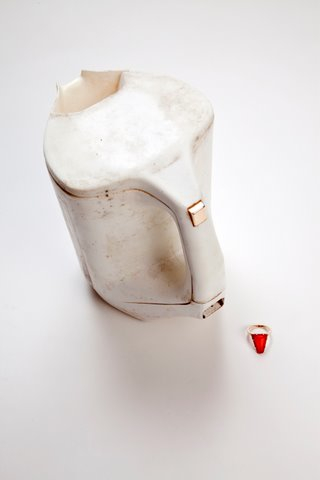
Function has been at odds with modern art. As Bertolt Brecht puts it, ‘There are times when you have to choose between being a human and having good taste.’ To limit work to its usefulness has been seen as a Puritan reduction of art for its own sake. This undermines the transcendental nature of art as a freedom to reflect upon the world, rather than being bound to it.
This situation is changing. With the ethical turn in recent times, we have seen a re-evaluation of function in art. The shift began with the emergence of relational aesthetics at the end of the twentieth century. In reaction against commodification in the art world, the relational paradigm read art in terms of its audience relations. The artist was no longer lone genius revealing higher truths beyond the everyday world. Instead, his or her role was to be a conduit for bringing people together in surprising ways. It was a dramatic move. Overnight, galleries became restaurants.
While the relational path helps recover a lost dimension of craft, in visual art it can go around in circles. Relational aesthetics has had limited success in broadening the social engagement in art beyond existing audiences – predominantly young, mobile, educated and urban. These are not new audiences: pre-existing art followers are just finding a more participatory way of engaging with art. In the relational context, it can be argued that craft and design have greater potential to intervene in the world.
This potential is evident now, particularly with the ethical turn in contemporary design. In 2007, the design ‘guru’ Philippe Stark made the public confession that ‘today I’m so ashamed to make this job.’ Stark called for a much less glamorous approach to design, with an emphasis on practical improvement, ‘even if it’s for toilet brush.’ Stark’s act of contrition is accompanied by a wave of philanthropic design, such as the Cooper Hewitt exhibition Design for the Other 90%, which highlighted proposals for improving living standards in poor communities. The ethical design movement is to be welcomed not only as a more egalitarian focus, but also as fresh source of innovation in the field. But there is a danger.
Unfortunately, ethics is fashionable. Recently Oxfam ran an advertisement of a pig in leotards in order to console anxious patrons that ‘Giving will never go out of fashion.’ The need to make this statement at all is an indication that even ethics can become a bandwagon and what comes up the fashion swing will inevitably come down as last year’s fad. For this reason, it is imperative that ethical craft and design remain innovative and not rest on its laurels, no matter how worthy. The works developed by jewelers in this exhibition demonstrate much scope for innovation.
Distributed Jewelry
The world today provides increasing opportunities for jewelry to embrace social networking. One of Oxfam’s most popular items is the Little Travelers, produced by Hillcrest AIDS Centre Trust in South Africa. Purchasers are encouraged to send images of their little beaded bride dolls from various corners of the world. In the case of jewelry, an Argentinean painter Francine has produced a series of hand-made brooches featuring miniature versions of her painted landscapes. In Be My Walking Gallery, she encourages owners of her brooches to post online images of themselves wearing her works, effectively using jewelry as a distributed gallery. Like tracking devices, such distributed jewelry connects people together, despite their distances.
Such developments reflect the gregarious nature of contemporary consumption, finding new ways of bringing people in contact with each other. But also, from the other end, it suggests that the ever-expanding virtual communities need something real to ground themselves in our everyday lives.
Vicki Mason has been producing classic floral brooches that cleverly incorporate materials such as plastic and haberdashery. This work has been born out of a celebration of gardening. For this exhibition she has taken her interest onto the political stage and made work that engages with the issue of Australia becoming a republic. Her brooches feature a broken crown to highlight this issue. As it is, this would be standard practice for a jeweler seeking to make a statement with a work that goes on public display in a gallery setting. But Mason takes this further by releasing these works into the world on completion of the exhibition. Those fortunate enough to win a brooch for themselves at the exhibition opening will be required to agree to a covenant that commits them, in turn, to passing this brooch on to someone else. For anyone to receive the brooch, they must fulfill certain conditions: they must express an interest in it, be aware of its relation to the republican cause and be willing to give it over to someone else in turn. The covenant is similar to systems such as Copyleft, which agree to use of intellectual property as long as it is not for restricted private gain. And like the use of tags in the Culturing the Body (2002) project by Roseanne Bartley, the jewelry functions to collect responses to an idea.
There are certain kinds of mass ornament that have emerged alongside social networking. They carry its spirit, but are not formally connected to online activity. The Make Poverty History bracelet was widely adopted as a sign of solidarity around issues of global equity, particularly the crippling debt owed by African countries. Promoted by celebrities such as Bono, it was designed to press the issue around initiatives such as the Millennium Development Goals.
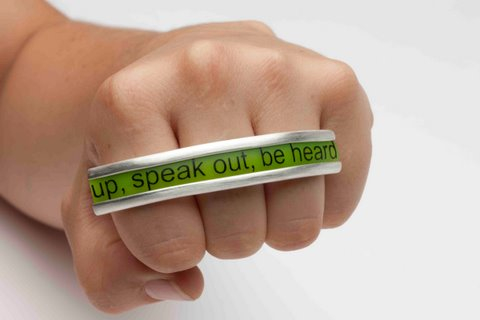
At the street level, one of the most successful items of jewelry is the DIY friendship bracelet. Produced by braiding several threads of wool, this bracelet has become a universal means by which individuals mark a personal commitment to another.
Areta Wilkinson has developed a substantial career as a jewelry artist with some of New Zealand’s most impressive recent exhibitions. Yet alongside these individual works, she has also developed a way of making a brooch that can be quickly learnt in a workshop. The Matariki star commemorates the Maori New Year based on the appearance of the Pleiades constellation. As social jeweler, Wilkinson has forged a method to disseminate this festival broadly through host hands and bodies.
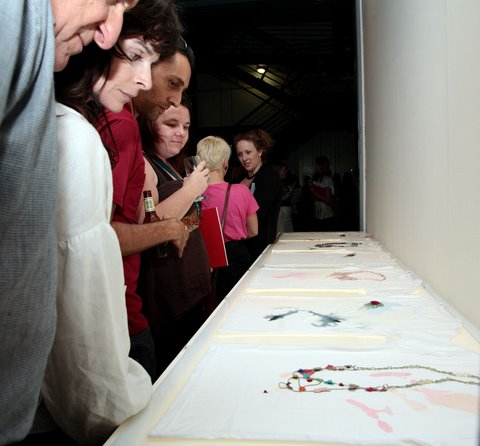
Change is Gonna Come . . .
Signs of Change is an opportunity to consider the public life of jewelry. While this may seem at odds with the inherently intimate nature of adornment, it reflects the mission of contemporary jewelry to critically engage with its place in the world. It is not just about ticking a box of political correctness. The do-gooder is easy to satirize. There is an experimental dimension of ethical design that challenges our preconceptions. The ethical mode of practice places significant responsibility in the hands of the jeweler. Once attached to a human host, jewelry has great potential power. We now see an alternative model of jewelry emerging – from the bench to the street. Artistic vision has been a productive context for the emergence of contemporary jewelry and will continue to be. But we see now a broadening context that enables jewelry to return to its place in everyday life – as useful device, social link or call for action, not only as testament to the taste of the individual wearer, but also as a sign of change in the wider world.



